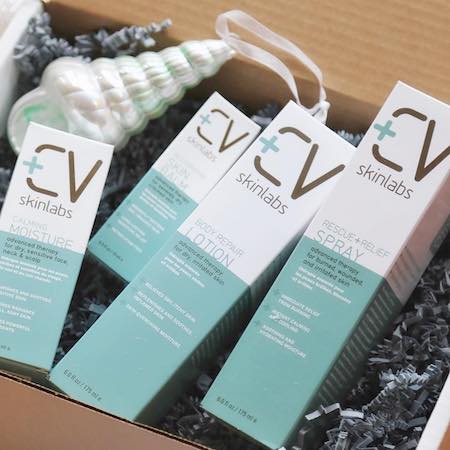Have you noticed more sagging skin lately?
As we age, our skin often no longer looks as firm as it used to.
Find out what causes this and the seven ways you can help improve the appearance of your skin without having to undergo a facelift or other similar invasive procedure.
What is sagging skin?
Sagging skin (or loose skin as it is often called) is skin that has lost its elasticity and cannot return to its original position. It hangs or sags on the skin (or other parts of the body) instead of holding firmly to the underlying muscles and ligaments.
We usually notice sagging skin first on our face. The skin around the eyes begins to sag, with the eyelids hanging more heavily over the eyes and the skin under the eyes loosening, sometimes causing “bags” to form.
We then often notice that the skin around the cheeks is sagging. It starts to pull down, creating lines from your nose to the mouth and bags under the chin. Sagging skin can also manifest itself in other places, such as under the arms and in the abdomen.
Why does this happen?
What causes sagging skin?
As we age, various changes take place in the skin.
First, the skin undergoes wear and tear. Exposure to the sun and the environment results in repeated attacks that the skin must repair. When you are younger, this repair system works efficiently so that you hardly notice the process. But as we age, this repair system slows down and the skin has a harder time keeping up.
At the same time, the skin loses some of the tools it needs to repair itself. Elastin and collagen are two important proteins that give the skin its strength and structure. The skin produces these proteins itself, but as the skin ages, their production slows down. Levels drop. Other factors also contribute to this decline.
- Sun exposure (UV rays)
- Pollutants in the environment, including cigarette smoke
- Lifestyle factors such as unhealthy eating or drinking too much
Although aging, wear and tear and slower repair processes are the main causes of sagging skin, there are some other factors that can play a role. Weight loss is a big one. If you have lost significant weight, you may notice that you have excess skin that is now sagging.
Pregnancy also stretches the skin and can leave sagging skin around the abdomen that doesn’t bounce back as well as you’d like.

7 Ways to Tighten Sagging Skin
You can undergo plastic surgery for sagging skin. There are face lifts, abdominal lifts, eyelid lifts and more that can help tighten the appearance of the skin. When the prolapse is severe, these are sometimes the only solutions that will make a noticeable difference. For example, if you have lost significant weight, you may want to look into these options.
However, if you’re not ready to go under the knife, several natural methods can help firm the skin.
1. Choose a high-quality moisturizer
Often the reason your skin starts to sag is because it isn’t getting the moisture it needs. Extremely dry skin has a compromised outer barrier, making it more vulnerable to the elements. Damage occurs more quickly and sagging accelerates.
You can stop the process by choosing a high-quality moisturizer that sends moisture to the deeper layers of the skin, where it can help plump the skin. Doing this will make the skin look more youthful, fine lines and wrinkles will fade, and sagging will be less noticeable.
The key is to always keep the skin hydrated. Apply a high-quality moisturizer in the morning and evening. If your skin feels tight in the middle of the day, reapply. We recommend our Calming Moisture and Body Repair Lotion as they both contain natural oils and extracts that promote recovery and healing.
Both are enriched with powerful antioxidants, ceramides and nutrients that help replenish moisture loss, stimulate collagen production and improve the elasticity of your skin.
2. Exercise
This may seem like an odd treatment option, but it can help, especially if you have sagging skin on the body caused by weight loss or pregnancy. Choose muscle-building exercises that can help reduce the appearance of mild sagging. Good options include weight lifting/resistance training and pilates.
Exercise can also help reduce sagging facial skin, if you opt for facial exercises. Also called facial yoga, these exercises work the small muscles in the face, relieving tension and tension, increasing blood circulation and creating a healthier-looking complexion.
The most important thing is that you maintain both workout routines (face and body) daily/weekly. Consistency produces results.
3. Consider supplements
You’ve probably heard of those facial firming supplements out there. Do they really work?
According to a Study from 2018, there is potential for that. In that study, participants were given a supplement containing collagen peptides, vitamin C, H. sabdariffa (Roselle), and A. Chilensis (Delphynol) once daily for 12 weeks. The researchers assessed their skin with high-frequency ultrasound and other methods.
The results showed a significant improvement in firmness and elasticity and an increase in skin thickness (thicker underlying layers) after the study period. The scientists concluded that the supplement could improve the signs of skin aging.
4. Try targeted anti-aging serums
Some anti-aging serums are specifically aimed at firming sagging skin. Those that contain ingredients like retinol can help improve elasticity around the eyes and other parts of the face.
Some sensitive skin types may find that retinol products cause breakouts. If that happens to you, don’t give up. There are many retinol solutions available, and many contain slow-release retinol or retinol encapsulated in other ingredients that work better for sensitive skin.
Dermatologists and estheticians recommend using our Calming Moisture after exfoliating and retinol treatments to help soothe, soften and hydrate red, inflamed, flaky skin. Gentle, hypoallergenic and non-comedogenic, it provides immediate results and accelerates recovery.
Another good ingredient to tackle sagging skin is vitamin C. It is a well-known antioxidant that supports collagen production. If your skin doesn’t have enough vitamin C, collagen production drops.
Skin firming creams also contain peptides and amino acids, as these help plump the skin and promote connective tissue repair.
5. Massage your skin daily
Just like any other organ in the body, your skin needs the nutrients carried in the bloodstream. Massage can help improve blood flow to the skin, which not only provides the skin with the nutrients it needs, but can also help remove waste products that damage the skin.
Massage can also stimulate fibroblasts in the skin. These are cells that help produce connective tissues such as collagen and elastin that keep the skin firm.
If you don’t want to massage your face with your hands, consider purchasing a facial massage product. There is some evidence that a handheld massager combined with an anti-aging cream can help increase the cream’s effect on facial wrinkles and neck sagging.
6. Try a coffee scrub
Coffee is good for your skin for several reasons. It contains protective antioxidants and firming agents that work together to make skin look brighter and more youthful.
A weekly coffee scrub can help reduce the appearance of saggy skin. Try mixing ¼ cup of finely ground coffee grounds in a bowl with 2 tablespoons of coconut oil (or olive oil or jojoba oil). Mix well and apply to the skin in circular movements.
If you have sensitive skin, do a patch test first to make sure the coffee grounds aren’t too harsh for you. Wash with lukewarm water and apply a moisturizer.
7. Try a non-surgical procedure
Several cosmetic procedures do not cut the skin, but rather treat it in a less invasive manner to promote tightening results. However, you may still need time to recover as these treatments can cause redness and irritation.
Talk to your dermatologist about this:
- Chemical peeling: This removes the outer layer of old skin, allowing younger skin to emerge. The result is usually smoother, less wrinkled skin.
- Ultrasound skin tightening: Technicians use ultrasound energy to stimulate collagen production in the skin.
- Radiofrequency treatment: Similar to ultrasound treatments, these methods transfer heat to the skin to induce collagen production.
- Pulsed light: These combine intense pulsed light (IPL) and radio frequency (RF) to heat the outer and deeper layers of the skin. They stimulate collagen production.
While you’re recovering from any of these treatments, make sure you don’t irritate your already sensitive skin. You need hydration, but clean hydration without potentially harmful chemicals. Our doctor-recommended Restorative Skin Balm is ideal for this purpose because it is 100 percent natural and petroleum-free. It is designed to prevent moisture loss, speed healing and protect the skin as it heals.
Apply the balm immediately after the procedure for a faster and healthier recovery.
How do you treat sagging skin?
Featured image courtesy of Michael Mims at Unsplash.






